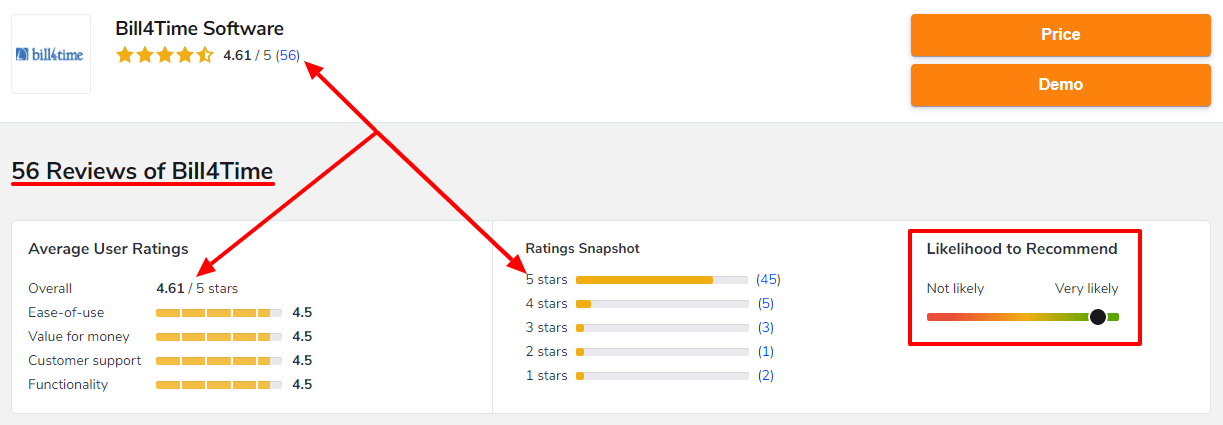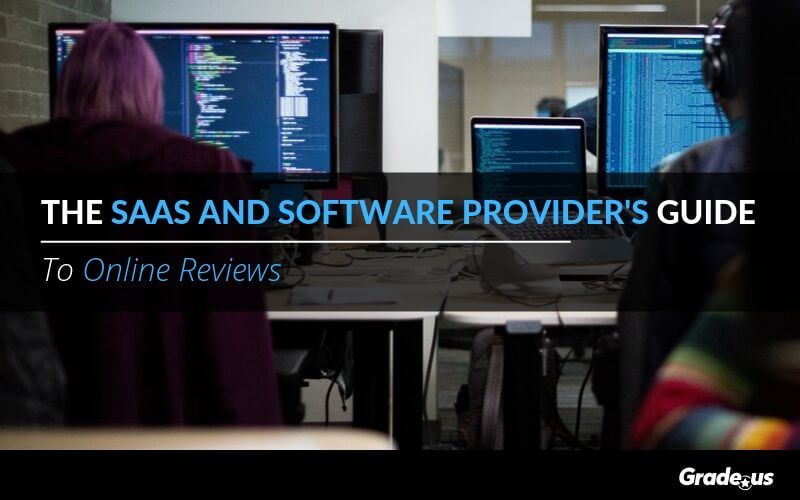Churn is inevitable.
If you're running a SaaS or software business, it's a consistent part of life. It's also directly opposed to growth. There are several ways to approach churn. You can track the causes driving churn, work to attract more customers and spend more time before and after qualifying customers.
These are all important steps to take.
They're effective, they work and they're important. But there's another strategy that's arguably more important than these each of these strategies.
That's right.
I'm talking about your software reviews.
Why software reviews are important to the industry
It's obvious why reviews are important to industries like restaurants, hospitality or automotive. It's not immediately obvious why reviews would be important to software companies.
Are they important?
Reviews are essential if you're focused on combating user churn. When we're talking about churn we're really talking about the impact churn has on your SaaS business.
1. Customers lost each month, quarter or year
2. The percentage of customers lost each month, quarter or year
3. The total monthly recurring revenue (MRR) lost
4. Percentage of MRR lost
If your SaaS or software business is growing, and you're working to reduce churn, it's reasonable to expect that you're able to outpace your churn rate.
That's the problem.
It's incredibly difficult to outpace your churn rate if you don't have a strong review portfolio. You need a strong review portfolio to:
a. Handle objections from prospective customers
b. Stand out from competitors
c. Attract new customers at a lower cost per lead
d. Increase your return on ad spend (ROAS)
e. Boost your conversion rates
Wait just a minute here.
Your online review portfolio only matters if customers rely on reviews to make their software purchases. Business-to-business, enterprise buyers and consumers all buy software without relying on reviews, right? What makes online reviews so important for software and SaaS providers?
Let's look at the data.
According to Demand Gen's 2017 B2B Buyer's Survey Report:
- 84% of buyers (B2B) seek input from peers and existing users (via reviews) during the purchase process
- 67% of buyers stated reviews were a very important consideration
- A TrustRadius report stated reviews are the #1 most-used resource that enterprise buyers can access without getting in touch with the vendor
- 59% of enterprise technology buyers used reviews as an information source when purchasing a new product
- 56% of executives – C-levels, VPs and company leaders – used reviews in the selection process
- Enterprise buyers are 7% more likely to seek out reviews than small to medium software buyers
- Buyers use reviews throughout the purchase process. 75% of technology buyers use reviews during the evaluation state
- 70% of enterprise buying stakeholders are part of researching and evaluating options
- 60% of millennials at enterprise companies use reviews. These millennials make up 61% of buying committees
- 73% of business technology buyers at enterprise companies believe understanding the cons is critical before making a purchase
- 71% of enterprise buyers are willing to advocate and share feedback on the record for the products they’ve purchased
- 33% of buyers look to their peers for confirmation when they’re ready to make a selection
- A product listing with less than five reviews is going to fall short for 79% of buyers
- 50% of buyers need 10 or more reviews per product to meet their needs
Several customer quotes from this TrustRadius survey confirm these findings.
- “Can’t trust the vendor, ever.”
- “We found some resources more valuable because they seemed independent, we studied how current users fared and how they reported their complaints and needs were handled.”
- “Directly working with the product along with dedicated user reviews provided a platform to evaluate all the uses of an application in detail and simulate a regular work environment in which the application can be validated.”
- “(Industry redacted) providers are known for their platitudes, and less known for the substance of their claims, so I took their marketing materials with a grain of salt. I much prefer hearing from people who have used the product, and other friends and colleagues who I trust.”
This data validates the important role reviews play with buyers. So naturally, this means software vendors are focused on building a strong review portfolio, right?
No, not so much.
Here's a screenshot of Gumroad. They're a well-known up and coming payment processor and product distributor.

No profile, zero reviews.

Same thing with G2.
They're doing well enough, so what's the big deal?
They should be doing better.
When it comes to software reviews, there's a significant degree of variance. It's still common for software/SaaS providers to focus their attention on traditional approaches to conversion and social proof.
- Product demos
- Case studies
- Webinars
- Marketing
But as we've seen, customers prefer reviews.
Does this mean these traditional methods are no longer important? Not at all. However, reviews play a more prominent role in your customer's decision-making process than traditional methods.
Which brings us to our next question.
Where are people searching for software companies online? The usual review platforms (Yelp) don't seem relevant or appropriate here.
Customers use these platforms to suss out reviews:
Why is this important?
Well, depending on your industry and the type of software you provide, you may need to provide reviews across a variety of platforms.
Here's an example.
Bill4Time provides attorneys and law firms with affordable, cloud-based, legal practice management software. They're a SaaS business, so their review portfolio is present on review sites like G2 Crowd:

On mobile sites like Google Play...


And on alternative platforms like Amazon's Appstore for Android

And on app-specific platforms like Software Advice.

Can you see what's happening?
Bill4Time has invested the time, energy and resources needed to build a strong review portfolio. If customers are present on their review platforms, they are too.
Here's why that's significant.
These review platforms typically have a significant amount of domain authority. Domain authority, as a metric, helps marketers gauge how well a site will rank. It describes a website's relevance on a specific topic or industry.
A strong review portfolio on each of these sites means more visibility in the search results. That's important because it can be difficult and expensive for SaaS providers to rank for competitive keywords. With review profile optimization, you can attract the kind of attention and results you need with less advertising and revenue.
Why software reviews are a competitive advantage
Customers are looking for unbiased feedback from your existing users. The information is important, yes, but it's not the most important factor here. Okay, which factor is most important?
That the information didn't come from you.
Your customers assume (correctly in most cases) that a conflict of interest exists. They're not interested in your self assessment. They're looking for feedback from your existing user base. A strong review portfolio means they have the data they need to make an objective assessment of your business and your product.
What customers learn from your user software reviews
- Customer desires
- Ethics
- Initial fears
- Objections
- Uniqueness
- Outcomes
- Values
- Frustrations
- Customer service
- Stories (good/bad)
- Results
- Sentiment
- Problems
- Pricing
- Trustworthiness
If you're able to present customers with the extensive details they need, you have a competitive advantage. What does this mean for SaaS and software providers then?
It's a good idea to ask customers for reviews!
How software and SaaS brands should request software reviews
There are four basic methods you can use to request a review.
1. Face-to-face. A face-to-face request is 34 times more effective than any other method. Notice I didn't use the word "in-person." A face-to-face request can be in-person, or online (via Skype or Blue Jeans), in a formal or informal setting.
2. Email. Asking for reviews via email is efficient. New users are highly responsive, especially if the request is made shortly after a conversion event (e.g., free trial, sign-up, purchase, opt-in, etc.).
3. SMS / Text Messages. Smartphones are ubiquitous today. Research shows 90% of all text messages are read within 3 minutes.
4. Social media. For better or worse, social media has built-in virality. Do something amazing or legendary for your customers and it spreads like wildfire. Make a mistake and it spreads even faster. When it comes to review requests, social media is a two-edged sword.
What does this mean then?
Which method is the best, most efficient way to request reviews from your users and customers?
All of them.
Layering your review requests (whilst including opt-out mechanisms) is a surefire way to increase your request conversion rates. Better yet, why not invite your customers to write a review?
Isn't that what a request is?
Not at all.
When you ask, it’s a favor. When you invite, it's prestigious.
But only if you do it right.
Email request template for software reviews
Subject: You're not only a good customer, you're...
You're one of our best customers.
[Customer Name], I’m reaching out to the top 3% of our customers. I'd like to learn about your experience with [app/software]. I only have six questions to ask, should only take 2 or 4 minutes.Would it be alright if we talked on the phone? Here's [my calendar link], feel free to choose a time that works for you. If you're busy, you can also share your thoughts here: [review funnel link] [Signature]
SMS request template for software reviews
Hi [Customer Name], [Your Name] here. Reaching out to the top 3% of our customers (you :). Are you willing to answer 6 questions? Only takes 4 min. [Review Funnel Link]
Face-to-face request template for software reviews
So [Customer Name], you're one of our best customers. You're super knowledgeable and it's been amazing working with you.
Would you be willing to answer six questions for us? Takes 2 to 3 minutes.
Appreciate you either way.
Social media request template for software reviews
Hey @customer-name, what did you think about [feature]? Would you be willing to answer 6 questions about [app/software]?
See what I did there?
I invited our top customers to share their feedback with us. Here's the amazing part about these templates.
They can be layered.
You can customize and arrange these templates in any way you see fit. You can send them out sequentially, all at once (not recommended), or at specific intervals and times. A face-to-face review request may not be scalable for software providers focused on volume. It could be perfect for enterprise software providers.
It all depends on your business model.
Who should be responsible for your reviews?
Again, that depends on your circumstances. It could be the co-founder's responsibility, something for marketing to tackle or customer service to-do. You'll want to give a specific department or team the responsibility for requesting and responding to reviews.
Choose one group.
Choose workers who are patient, highly agreeable and conscientious. The ideal candidate displays the appropriate levels of affective, cognitive or somatic empathy.
Using reviews in your software marketing
Earlier in this post, I mentioned a research data point stating that 75% of buyers use reviews throughout the evaluation and purchase process. You can mirror this in your marketing, increasing your conversion rate as a result.
Here's how.
Use remarketing and retargeting to promote your reviews at the beginning, middle and end of your customer's buying cycle.
1. Use PPC ads + review samples (or # of reviews) to capture customers at the beginning of the buying cycle, e.g., 5-star reviews from customers just like you
2. Remarketing and retargeting to communicate with customers who have recently visited your site
3. Use social proof + a review acquisition campaign via your autoresponder campaigns and remarketing to capture more reviews from satisfied customers
You can use your review portfolio, via third party sites, to warm up cold leads (i.e., prospects who've downloaded a lead magnet or subscribed to your email list). Next, use reviews with objections to convert warm prospects who've visited specific pages on your site (e.g., /pricing, /features or /faq) to hot prospects. Finally, you can direct these hot prospects to a conversion page (e.g., free trial, request a demo, contact sales, etc.).
It's simple, direct and efficient.
Software reviews are more important than ever before
Churn is an inevitable part of your software business.
Churn may be in direct conflict with your growth, but that doesn't mean you have to accept defeat. Churn has a measurable impact on your business in the form of lost customers and lost revenue.
This is why you need a strong review portfolio.
With a strong review portfolio, you'll find you're consistently able to outpace your churn rate. Your reviews overcome customer objections automatically. They set you apart from your competitors and boost your conversion rates. They bring in new customers at a lower cost per lead.
Everything you need to minimize churn, ensuring your MRR continues to move up and to the right.
About the Author
Andrew McDermott
Andrew McDermott is the co-founder of HooktoWin. He shows entrepreneurs how to attract and win new customers.










